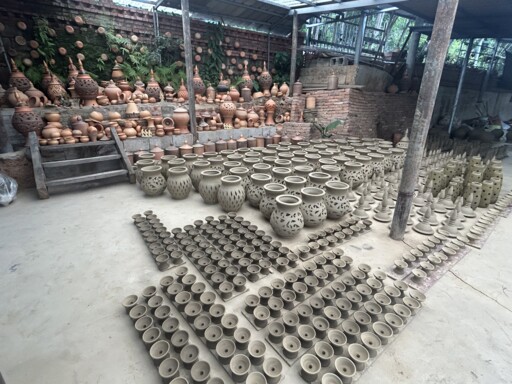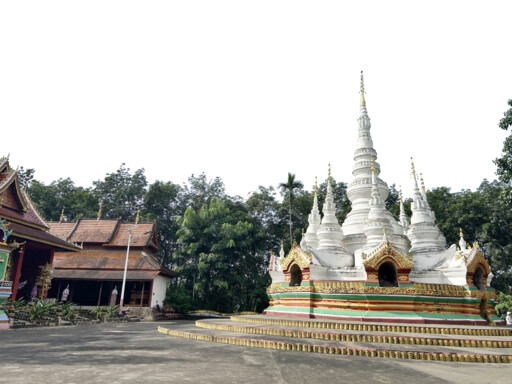


Immersion in tradition: Days spent in Xishuangbanna’s villages

The family pottery workshop of Yu Nan’en, an “inheritor” of Dai ceramic artistry Photo: PROVIDED TO CSST

The Manfeilong Pagoda at Damenglong, Xishuangbanna Dai Autonomous Prefecture, Yunnan Province Photo: PROVIDED TO CSST
Every return to Yunnan for fieldwork brings encounters with sincere and warmhearted people. In the summer of 2025, I formed a “fieldwork team” with two fellow scholars, and together we traveled to Xishuangbanna for research. Along the way, countless unforgettable experiences unfolded, and the stories we collected became the most cherished memories of our fieldwork journey.
Songs of ‘zhangha’ from Dai tradition
We went to Damenglong [in Xishuangbanna Dai Autonomous Prefecture, Yunnan Province] in search of a Dai singer known as a zhangha [referring singer in the local language]. Villagers urged us to visit Mansan Village, where a renowned female zhangha named Yu Yingwan lived. At the village entrance, we stopped at a small family-run restaurant. An elderly woman in her eighties was rinsing dishes by the doorway. We asked, “Could you tell us the way to zhangha Yu Yingwan’s home?” To our astonishment, chance brought us directly to her—smiling, the old lady replied, “This is her home. I am her mother.” She warmly invited us inside.
She seated us at the table in the main hall, explaining that her daughter would be home shortly. Then she served us tea, along with mangoes and bananas from their own orchard—the mangoes picked from the garden behind the house, the bananas naturally ripened and fragrant. Famished by our travels, we ate eagerly and heartily. The grandmother then brought out a plate of sticky “thumb” corn [an old glutinous variety from Xishuangbanna, each cob no larger than a finger], tender, chewy, and sweet. Seeing our delight, she thoughtfully offered cool spring water and Oriental melons. In this cozy Dai stilted house, she treated us as though we were her grandchildren returning home, and we, in turn, regarded her as our own elder.
Her daughter, the hostess Yu Yingwan, is a multi-talented Dai woman whose melodious voice is admired across Dai communities in Myanmar, Thailand, and Laos. She told us that she had been drawn to singing since the age of six, when she would sing in exchange for candy. Her passion persisted through the years. In 1997, she formally apprenticed under Yu Guang, a national-level “inheritor” of the Dai zhangha tradition. Today, she herself is recognized as a provincial-level “inheritor” of the art, and has begun training disciples scattered across Xishuangbanna as well as in Myanmar, Laos, and Thailand.
That evening, while savoring Dai delicacies, we listened to recordings of her songs and her stories—of childhood performances, of singing at “Meng God” [a deity within Dai belief systems] ceremonies, and of her lifelong bond with her husband. The hours slipped away until deep into the night. Zhangha singers are vital carriers of Dai poetic traditions; their devotion ensures that a millennia-old song lineage remains vibrant today.
Bulang villages amid ancient tea trees
In the mountains of Xishuangbanna, different ethnic groups live along vertical zones of elevation: Dai people cultivate rice in the flat valleys, Bulang villages are scattered on the green mid-slopes, while Hani and Jinuo peoples inhabit the misty summits. This distribution reflects nature’s endowments: Higher altitudes yield premium tea, binding mountain peoples to its cultivation for generations.
We climbed into the mountains in search of the Bulang. At Mansan Village, we came upon a tea-processing workshop at the village entrance. A woman named Yu Ying sat behind a long tea table on a balcony. Seeing us, she warmly invited us inside, swiftly fetched her treasured tea leaves, and began boiling water to brew tea.
Switching between Mandarin and Dai language, she explained that Bulang and Dai have lived side by side for centuries, so most Bulang people can also speak Dai. She told us she had married within the village after finishing primary school, raising two children who now study tea-related majors at vocational schools in Jinghong, preparing to inherit the family tea business. According to her, this small Bulang village of about thirty households lives off tea, lychees, and rubber. Many who once left for migrant work now run businesses at home, and nearly every family has built new houses; “left-behind children” and “empty-nest elders” are now a thing of the past. On these misty tea mountains, tradition and modern life quietly intertwine, with the fragrance of tea as their enduring bond.
Another Bulang village we visited was Manbi, also perched halfway up a lush slope. Its name carries a poignant legend, as Bi in the local language means “abandon” or “leave behind.” According to oral tradition, the village’s ancestors were attendants escorting a Lao princess to marry the Dai king. Separated from the entourage halfway, they settled here, transforming an unfinished journey into a permanent home.
Inside Manbi’s modest yet quietly dignified Buddhist temple, we were surprised to find many preserved scriptures written on mian paper [made by a special papermaking technique introduced from the Indian subcontinent, widely distributed in South Asia and Southeast Asia, yet completely different from traditional Chinese papermaking methods]. We carefully leafed through the yellowing manuscripts, which included long narrative poems about the common origins of the Han, Dai, Bulang, and Hani peoples. To my delight, I also found the long-sought text of Ya Huan Hao [“Grandmother of the Grain Soul,” a goddess in Dai mythology]. Senior scholars had often remarked that texts missing from Dai areas could sometimes be rediscovered in Bulang villages.
Manbi is also home to a renowned bo zhangha (male singer), Yan Guangyang, whose life epitomizes zhangha tradition: At 11, he entered a monastery to study Dai script, mentored by his foster father and later master Yan Xiangyue, who used zhangha songbooks for his instruction. At 14 he left the monastic life, and at 17 formally apprenticed in the danghan initiation ritual. By 19, he was already traveling from village to village to sing. When I mentioned the female zhangha Yu Yingwan, his eyes lit up—she had been his “old rival” in nearly fifty singing duels.
What astonished me most was his collection of two precious songbooks containing chapters from the creation epic Bata Maga Peng Shangluo [the Dai people’s creation epic]. As a scholar of Dai literature, this epic has long been my focus—a text I had analyzed repeatedly in archives. To see it alive in the handwritten manuscripts of a living zhangha singer was profoundly moving—an unforgettable moment where scholarship met living tradition. In this ordinary Bulang village, I touched the living pulse of ethnic literary heritage. Yan Guangyang now has four grandsons, the youngest only six, already learning Dai script with him and perhaps destined to inherit the songs as well.
Glow of pottery in Dai village art
Anyone visiting Damenglong usually stops at Manfeilong Pagoda [a cluster of towering stupas in the typical architectural style of Theravada Buddhism, built in the early 13th century]. But for me, the most enchanting aspect of Manfeilong village was its rustic Dai pottery. Wandering its quiet lanes, I saw lush greenery on both sides and, in front of nearly every house, brown clay lantern jars. Their delicate cut-out patterns cast dappled shadows in the sunlight, their simple forms touched with subtle elegance. At night, when lit from within, they must create dreamlike scenes.
In one lane, I met a kindly old Dai lady who told me that several pottery families still worked in the village. One of them, located by the fishpond at the foot of the mountain, is the workshop of Yu Nan’en, a provincial-level “inheritor” of Dai pottery. Following the trail of clay jars through bamboo groves, we arrived at a cluster of stilted houses. It was a sizable workshop: the husband shaping clay bodies, Yu Nan’en refining the forms, the daughter-in-law carving patterns. Rows of drying vessels lined the yard. The neighboring house served as both their residence and as a showroom for finished pieces—life and art blended seamlessly.
Yu Nan’en warmly invited us inside, offered us seats, and brought out a variety of tea sets to show us. Under the sunlight, the vessels revealed different sheens: light gray pieces fired with Pu’er clay, black ones made from the renowned Jianshui clay, and warm, reddish-brown works from the local clay. The distinctive texture of coarse pottery flowed beneath our fingertips, with every line and groove telling of the craftsman’s devotion.
When Dai people participate in their various ceremonial activities, they always don festive attire and ornament themselves with gold and silver accessories. During festival seasons, it is common to see small stalls set up by Dai women—some selling silver jewelry, others offering Dai brocade clothing, and some displaying exotic flowers and fruits. Dai silver, in particular, caught our attention: earrings adorned with flowers and tassels that jingled in the breeze; bracelets in flat, round, or square shapes, glowing with a pure, moon-like sheen; and slightly extravagant bud-shaped necklaces with a distinctive elegance. There were also pagoda-shaped hairpins made from gold foil—Dai women, devout Buddhists who make frequent offerings, often wear a pagoda-style hairpin atop their heads.
Although life is demanding, Dai women know how to live their days poetically. They keep their stilt houses clean and elegant, decorating the front and back of their homes with fresh flowers and greenery. Even after a day of labor, they change into finely crafted tube skirts and arrange their hair meticulously. This dedication to beauty lends poetry to everyday life and infuses even the hardships of life with a quiet dignity.
Qu Yongxian is an associate research fellow from the Institute of Ethnic Literature at Chinese Academy of Social Sciences.
Editor:Yu Hui
Copyright©2023 CSSN All Rights Reserved